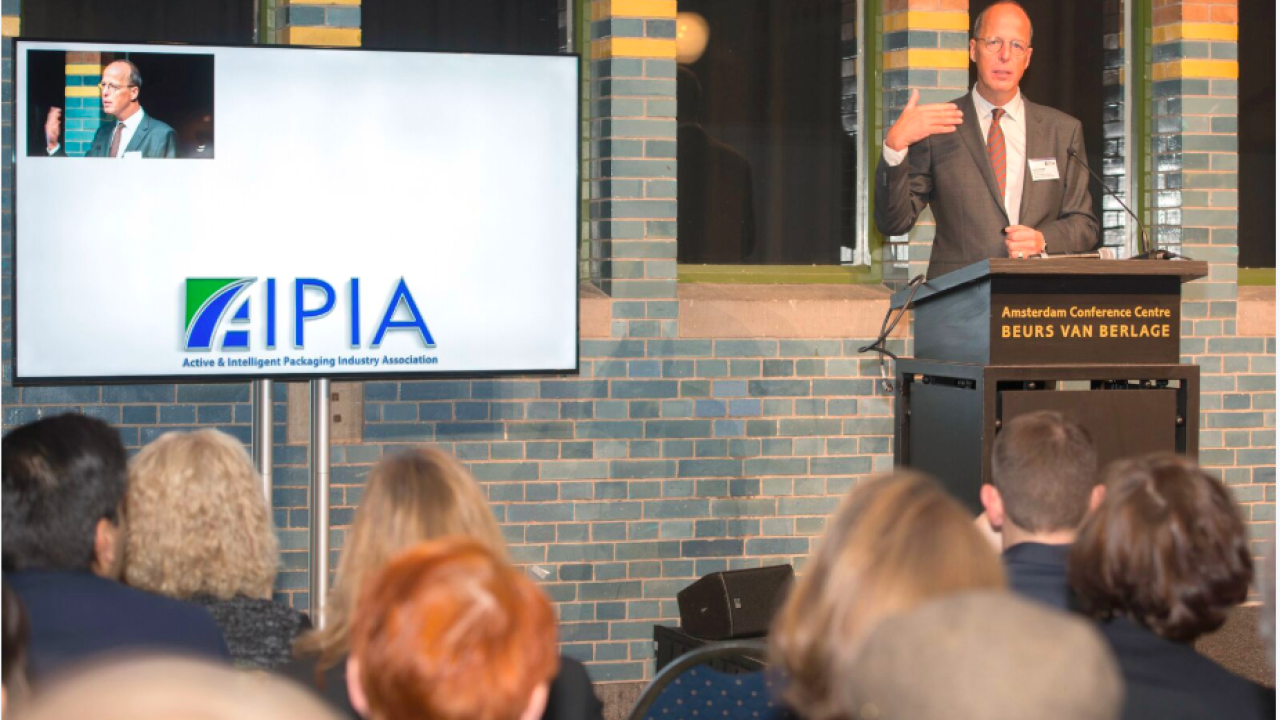Investigating active and intelligent packaging

It is evident that active and intelligent packaging technologies have become a much more common occurrence in recent times. They have taken on many forms, been used to deliver different results, and have broadened their reach into new markets and applications. For instance, CCL-Kontur has produced promotional labels for Miller Alcohol Free bottles in Russia featuring NFC tags that function as an active recording device. Selinko and Toppan Printing have launched a device that combines a sensor coupled with an RFID/ NFC tag for authentication and consumer engagement. WestRock has introduced connected packaging for smart products combining Digimarc’s enabled barcode technology with Evrythng’s IoT smart products platform. This last example has brought embedded, real time, connected digital intelligence to billons of WestRock packages, in-store signs and displays produced annually.
‘IoT is a megatrend that is gaining exponential traction and every day we see more products enabled with NFC solutions coming onto the market,’ comments Paolo Bavaj, head of corporate venturing and scouting at Henkel Adhesive Technologies.
For mass serialization specialist Kezzler, IoP – Internet of Packaging – is already here, with the digitization of products opening an interactive highway of information connecting stakeholders across the value chain, from brands and consumers, to manufacturers and regulators. This is being enabled by serialization at mass scale, where encrypted unique IDs carry and transmit information throughout every step of the product cycle.
Value
John Beerens, head of sales at Kezzler, identifies how pre-serialization allows for everyday products to be connected via IoP, both engaging consumers and providing brands with a powerful anti-counterfeiting tool. This can, and is being achieved for mass volumes despite cost and logistical concerns. Kezzler and Amcor’s MaXQ technology allows for the secure storage of printed codes, which can later be activated on the production line.
Smart packaging is a strategic innovation initiative at Henkel Adhesive Technologies, principally through the implementation of NFC technology. It has expanded its NFC smart packaging activities through the launch of the Indola #SimplySmarter line. Indola, a Henkel professional hair care brand, uses three styling products connected via NFC tags as a way to inspire professional hairstylists. With a volume of 100,000 products to be rolled out in 35 different countries, Indola #SimplySmarter is said to be one of the largest NFC pilots in the beauty care market to date. Professional hairstylists tap the Indola product with an NFC-enabled smartphone and a landing page is opened. It displays product information, how-to videos by celebrity ambassadors and a curated Instagram wall. For Indola, Henkel partnered with All4Labels and Goodstag, an IoT platform, to encode and digitally connect the NFC tags.
‘Smart packaging allows Henkel to empower brands with a holistic solution to address their consumer pain points,’ says Bavaj.
Dr Shira Rosen, packaging development manager at Strauss Group, underlines the importance of such work in ‘activating’ and leveraging consumers, and having them engage with a brand across multiple channels through creating an experience or value to them, which in turn creates value for brands with the data collected and returned a highly prized resource.
Skanem’s Maryne Lemvik, executive vice president of product and business development, explains how smart labels can be used to achieve this in a number of ways. From different promotional activities, to overt and covert security measures, and a complete picture of the supply chain. And covering both the physical world and cloud-based assets. ‘Smart labels are powerful tools, with one scan allowing promotion, protection and traceability.’
For applications such as product promotion, protection and tracking, Skanem has introduced Smart Labels. They can feature RFID, NFC, hidden codes, and machine- and human-readable codes. Skanem handles all elements of Smart Labels, from design, printing and conversion, to connectivity and analytics. All information is stored and managed via a cloud-based data management system.
‘In the future, all labels will be smart,’ she remarks.
To get to that point, she notes Skanem’s work to demystify the topic by approaching each project case-by-case and identifying where the benefit from smart packaging lies. Kevin Lewis, strategy and marketing, digital manufacturing at Xerox, reiterates this point, and that the future is very much about smart packaging. He notes similarities to how the print market has embraced digital technology as a means to create value.
However, creating smart packaging is not as simple as adding low-cost electronics to a physical package, he describes, rather requires a holistic view on the product and components, software, ecosystem, and the value relationship between the brand and the consumer.
‘There is an optimal level of “smart”, and smart enough is OK,’ Lewis continues. ‘Smart must be appropriate to the application.’
AR in action
For Martin Stahel, Zappar sales director, smart packaging technologies, such as augmented reality (AR), are a strategic tool for brand owners. ‘You are sitting on a powerful media space, which you should take control of and unlock the value in.’
An example of this has been Treasury Wine Estates (TWE) and its 19 Crimes campaign. Partnering with AR company Tactic, a series of animated characters have been created for TWE’s wine labels. Once the consumer downloads an app and points their phone camera at a bottle on the shelf, the character on the label becomes animated and tells his personal crime story. The shopper can also share the AR experience on social media.
Michelle Terry, TWE chief marketing officer, Americas, comments: ‘19 Crimes defies convention – this is a wine brand that tells a rich and authentic story, and has proven to have strong appeal to millennial consumers. It is without doubt one of our most successful innovations.’
Shazam, a service long identified with music, has introduced its own AR platform as it continues its transition from audio to visual services. While Shazam has offered visual-recognition functionality since 2015, AR functionality, powered by Zappar codes, was introduced last year and in conjunction with spirits company Beam Suntory. Consumers in the US who used Shazam to engage with Sauza or Hornitos tequila in-store creative were offered the chance to play a co-branded AR interactive memory game.
With the rollout of the AR campaign in the lead up to Cinco de Mayo, Beam Suntory identified it as allowing the Sauza and Hornitos tequila brands to ‘effectively break through the Cinco de Mayo advertising clutter’.
Michelle Cater, senior director of commercial marketing at Beam Suntory, explains: ‘This breakthrough technology offers an accessible, immersive platform with which to engage in a rewarded gamification experience at the point of purchase.’
For Shazam, its existing install base allows it to offer AR at scale. ‘The possibilities for a brand to bring their products to life or make their advertising more engaging are quite literally only limited by the imagination,’ proclaims Shazam chief revenue officer Greg Glenday.
Bob Pernice, director of market development, intelligent labels at Avery Dennison, states: ‘Labels have always been smart, now it’s about intelligence.’
Avery Dennison has a strong presence in intelligent labels through RFID, including a global RFID partnership agreement with Target Corporation. This forms part of Target’s deployment of RFID technology to more than 1,600 stores to help maximize inventory availability and deliver an enhanced guest experience. With Ferm RFID Solutions, Avery Dennison has created a tire tread label with worldwide RFID functionality, which allows entire pallets of tires to be read in a single pass. Avery Dennison and L&L also hosted a series of webinars on RFID technology (available for catch-up at www.labelsandlabeling.com).
RFID specialist SML has recently moved into tangential markets that it has identified to benefit from item-level RFID technology. Sharing many of the same business case elements and omnichannel models that are driving adoption in the apparel and footwear segments, SML is now active in: mobile phones and accessories; cosmetics and fragrance; eyewear; wine and spirits; food; and retail pharma.
‘All of these segments have significant issues with inventory accuracy, and when you combine state-of-the-art RFID tag technology with best-in-class item-level inventory management functionality, unprecedented results are easily available,’ proclaims Dean Frew, CTO/SVP, RFID Solutions at SML Group.
Stay up to date
Subscribe to the free Label News newsletter and receive the latest content every week. We'll never share your email address.


